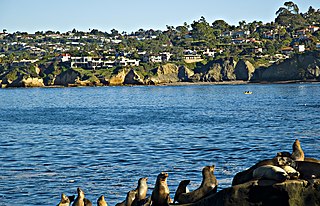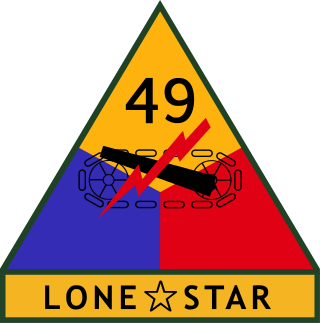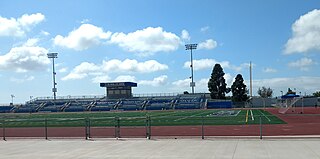
San Diego is a city on the Pacific coast of Southern California, adjacent to the Mexico–United States border. With a population of over 1.3 million residents, it is the eighth-most populous city in the United States and the second-most populous in the state of California, after Los Angeles. San Diego is the seat of San Diego County, which has a population of nearly 3.3 million people. It is known for its mild year-round Mediterranean climate, extensive beaches and parks, long association with the United States Navy, and its recent emergence as a healthcare and biotechnology development center.

The 49th Armored Division —nicknamed the "Lone Star"— was an armored division of the Texas Army National Guard during the Cold War.

Interstate 805 (I-805) is a major north–south auxiliary Interstate Highway in Southern California. It is a bypass auxiliary route of I-5, running roughly through the center of the Greater San Diego region from San Ysidro near the Mexico–U.S. border to near Del Mar. The southern terminus of I-805 at I-5 in San Ysidro is less than 1 mi (1.6 km) north of the Mexican border. I-805 then traverses the cities of Chula Vista and National City before reentering San Diego. The freeway passes through the San Diego neighborhoods of North Park, Mission Valley, Clairemont, and University City before terminating at I-5 in the Sorrento Valley neighborhood near the Del Mar city limit.

The M60 is an American second-generation main battle tank (MBT). It was officially standardized as the Tank, Combat, Full Tracked: 105-mm Gun, M60 in March 1959. Although developed from the M48 Patton, the M60 tank series was never officially christened as a Patton tank. It has been called a "product-improved descendant" of the Patton tank's design. The design similarities are evident comparing the original version of the M60 and the M48A2. The United States fully committed to the MBT doctrine in 1963, when the Marine Corps retired the last (M103) heavy tank battalion. The M60 tank series became America's primary main battle tank during the Cold War, reaching a production total of 15,000 M60s. Hull production ended in 1983, but 5,400 older models were converted to the M60A3 variant ending in 1990.

State Route 163 (SR 163), or the Cabrillo Freeway, is a state highway in San Diego, California. The 11.088-mile (17.844 km) stretch of the former US 395 freeway runs from downtown San Diego just south of an interchange with Interstate 5 (I-5), extending north through historic Balboa Park and various neighborhoods of San Diego to an interchange with I-15 in the neighborhood of Miramar. The freeway is named after Juan Rodríguez Cabrillo, the first European to navigate the coast of present-day California.

State Route 52 (SR 52) is a state highway in San Diego County, California, that extends from La Jolla Parkway at Interstate 5 (I-5) in La Jolla, San Diego, to SR 67 in Santee. It is a freeway for its entire length and serves as a major east–west route through the northern part of the city of San Diego. The road connects the major north–south freeways of the county, including I-5, I-805, SR 163, I-15, SR 125, and SR 67. SR 52 passes north of the Rose Canyon Fault before traversing Marine Corps Air Station Miramar. East of Santo Road and west of SR 125, the highway goes through Mission Trails Regional Park, a large open preserve. SR 52 is also known as the Soledad Freeway and the San Clemente Canyon Freeway.

Linda Vista is a community in San Diego, California, United States. Located east of Mission Bay, north of Mission Valley, and south-east of Tecolote Canyon, it lies on a mesa overlooking Mission Valley to the south and Mission Bay and the Pacific Ocean to the west. It is home to the University of San Diego.

Gerald Robert "Jerry" Sanders is an American former politician and law enforcement officer from San Diego, California. He served as the 34th mayor of San Diego and was chief of police of the San Diego Police Department. As of December 2012, he is the president and CEO of the San Diego Regional Chamber of Commerce.

Clairemont is a community in San Diego, California, United States. It has a population of about 81,600 residents and an area of roughly 13.3 square miles (34 km2). Clairemont is bordered by Interstate 805 on the east, Interstate 5 to the west, State Route 52 to the north, and the community of Linda Vista to the south. The community of Clairemont can be subdivided into the neighborhoods of North Clairemont, Clairemont Mesa East, Clairemont Mesa West, Bay Park, and Bay Ho.

Kearny Mesa is a community in the central part of San Diego, California. It is bounded by State Route 52 to the north, Interstate 805 to the west, Aero Drive to the south, and Interstate 15 to the east. Adjacent communities include Serra Mesa, Clairemont and Tierrasanta.

Cleophus Prince Jr. is an American serial killer who was convicted and sentenced to death in 1993 for the rape and murder of six women in San Diego County, California. The killings occurred between January and September 1990 and became known as the Clairemont serial killings as most of the murders took place there. Before these crimes and while serving in the United States Navy, Prince was court-martialed in 1989 due to larceny. Upon being convicted, he was recommended to be discharged after serving his sentence. Multiple books have been written on Prince and his crimes.
Birdseye is an unincorporated community in southeastern Utah County, Utah, United States.

The San Diego Police Department (SDPD) is the primary law enforcement agency of San Diego, California. It was established on May 16, 1889. The department employs 1,731 officers and 601 civilian staff. It covers 343 square miles of service area with a population of over 1.4 million people. It is the second-largest municipal police department in California, after the Los Angeles Police Department.

James Madison High School is a public high school in San Diego, California. It is part of San Diego Unified School District. Madison's 50-acre (200,000 m2) campus opened in 1962. Serving almost 1,100 students in grades 9–12, it is located in the Clairemont Mesa East neighborhood, north of Balboa Ave, south of Clairemont Mesa Blvd, and west of Interstate 805.

A National Guard Armory, National Guard Armory Building, or National Guard Readiness Center is any one of numerous buildings of the U.S. National Guard where a unit trains, meets, and parades. A readiness center supports the training, administration, and logistics of National Guard units by providing assembly space, classrooms, weapons and protective personal equipment storage, and training space. Readiness centers can also be utilized as communal assembly areas, utilized by local organizations and governments.

"The Right to Go Insane" is a song by American heavy metal band Megadeth, written by Dave Mustaine. It is the final track and second single from their twelfth studio album Endgame. The song was commercially released as a single on April 9, 2010, and a music video was released directed by Bill Fishman, who produced the music video of the band's previous single, "Head Crusher". The music video was based on the real-life events surrounding Shawn Nelson's descent into madness and the famous tank rampage he engaged in which led to his death.

The 149th Armored Regiment was an armored regiment that was part of the California Army National Guard. Its lineage dates back to a cavalry unit organized in 1895 in Salinas. As Troop C, the unit's first major action occurred when it deployed to help in the aftermath of the 1906 San Francisco Earthquake. In 1916, still as Troop C, the unit served along the Mexico–United States border near Nogales, Arizona to deter further border incursions, due to events surrounding the Pancho Villa Expedition. The following year, Troop C was activated then reorganized and redesignated as Company B, 145th Machine Gun Battalion upon the United States' entry into World War I; as part of the 40th Division, the battalion deployed to France in 1918, and returned to the United States in 1919.

The 1959 San Diego F3H crash was the crash of a United States Navy McDonnell F3H-2N Demon in San Diego, California, on 4 December 1959. The pilot, Ensign Albert Joseph Hickman from VF-121, chose not to eject from the stricken aircraft, piloting it away from populated areas of Clairemont, including an elementary school, saving "as many as 700 people" on the ground, according to one estimate. The aircraft crashed into a canyon, with the pilot being the sole fatality. Hickman has been memorialized in the naming of an elementary school and a sports complex in San Diego. Several decades later, a similar crash occurred in University City, a neighborhood north of Clairemont.

This is a list of protests that took place in San Diego County, California, following the murder of George Floyd that took place on May 25, 2020 in Minneapolis, Minnesota, after police officer Derek Chauvin knelt on his neck for 9 minutes and 29 seconds. These events were created to fight for justice for George Floyd and other Black community members who suffer from police brutality. These demonstrations resulted in a number of policy changes, namely the ban of the cartoid neck restraints use in San Diego County and a city-wide independent review board that would review police practices.
Tank rampage may refer to:




















